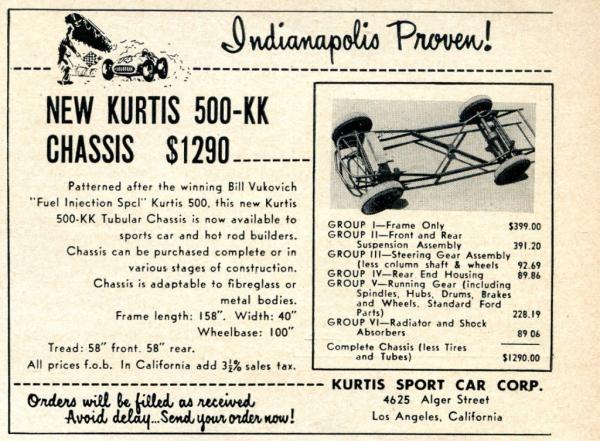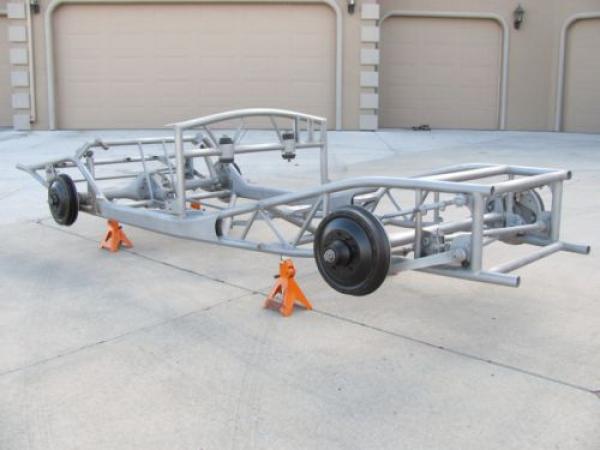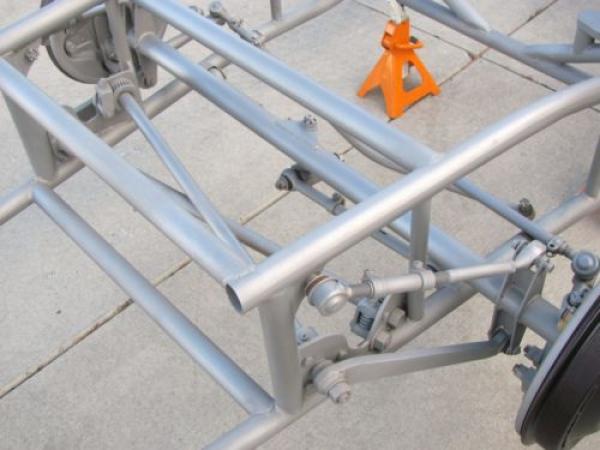Frank Kurtis may be known for his winning midget and Indy cars, but he also built a handful of Indianapolis inspired street cars. Any of us would love to own one of these American made sports cars, but the cost and rarity make that a dream for most. This may just be a frame, but it is one step closer to that dream. It looks like it could have just came out of Frank’s shop and it is listed here on eBay with bidding at $2,025 and the reserve not met.

Back in the fifties, many people attempted to build their very own sports cars. There were many sleek fiberglass bodies available from companies such as Glaspar and Devin. All you had to do was weld up your own frame and stick the new body on top. Things were not always that simple though and some builders did not have the tools or skills required. Frank saw an opportunity and took advantage of it by offering a frame just for these DIYers. Forgotten Fiberglass has a nice write up with more information.
The seller claims that they acquired it from the family of the original purchaser in Nevada. The first owner had bought it from Kurtis with hopes of building their own car, but never even fitted an engine. As a result, the frame looks like new and is ready to be used for your own project. The build quality is outstanding and it features their famous torsion bar suspension which helped keep things stable at high speeds.
There are many routes that could be taken with this build. You could source a fiberglass body or have an aluminum one built. A period correct Cadillac V8 would look great under the hood or you could go with a more modern lump. Finances would be the only limiting factor here. So, what would you do with this blank canvas if it were sitting in your shop? Thanks to Kyle K for alerting us of this one.



I emailed the Seller to ask about a chassis number. He wrote: “This chassis does not have a serial# that I can locate. After reading the Kurtis featured article in the June 2009 issue of Hot Rod Magazine by Jim Youngs, He states that chassis numbering was not one of Kurtis’ priorities.”Does anyone know if there were original Kurtis KK chassis built without a chassis number? Over the years I’ve seen several Kurtis KK chassis/cars and all the ones I’ve inspected had a chassis number.
When a chassis was built to be a race car, in that era, they were hardly ever numbered. Some wound up getting numbered in order to plate them for street use. Not having a number on this chassis isn’t a big concern in my opinion.
For what a genuine Kurtis chassis should sell for, I’d feel a lot more comfortable with a chassis number.
Kurtis also built the start carts for the SR-71. At least one has been restored. I’d love to know if the frame for one of those, looks like an Indy car frame?
I respectfully disagree with R.J. Denton who wrote, “When a chassis was built to be a race car, in that era, they were hardly ever numbered.” While it is true that some home-builders of one off “Specials” did not assign a chassis number to their creations (and by the way, many of them did assign a number), that was not the case with manufacturers.Builders like Devin, Balchowsky Kurtis, and others DID routinely assign chassis numbers. There are a few good books on this subject and a quick scan will show that almost all American manufacturers of cars and chassis in the 1950s DID assign chassis numbers to their cars/chassis.As an example, I have an original Kurtis KK chassis in my collection and it absolutely DOES have a Kurtis KK chassis number. A chassis number is not everything but it is the very thing that identifies each particular car…that’s why manufacturers used them.With the increasing value of historic cars and with the regrettable influx of fakes, clones and replicars on the market, a chassis number is becoming and will continue to become increasingly important.Many events around the world are now only accepting cars that are certified by groups such as FIVA and others and it would be extremely challenging to certify a car lacking a chassis number.The Seller on ebay states in his advertisement: “I have documented history that has been notarized for authenticity.”It remains up to each individual buyer whether that is enough documentation to invest in this project. For me, I’d feel more comfortable investing in a project with a Frank Kurtis issued chassis number.
Mark, I accept your authority. I looked at buying a Kurtis a while back from a very respected dealer in the East Bay. It did not have a chassis number. I didn’t buy it, but not for that reason.I would imagine another tell tale is get a welding expert to look at it. That could be pretty definitive if it were, say, MIG welded. LOL
Hi R.J.:I’m certainly not a weld expert so I couldn’t offer any opinion in that regard. And since I have no historical information at hand on this particular item, I’m also not in a position to offer an opinion regarding the lineage of the chassis for sale on ebay.My point is that without a chassis number there are always going to be questions asked about this chassis or a car that’s built up from it. With the expense associated with turning this chassis into a car, collectors simply need to consider if those questions will be a minor nuisance or if they will haunt them and this project in the future.
Well, that’s a tricky one. Even if we apply all good faith in the world, the combination of an immaculate frame from the ’50s, without a chassis number, is a tough act to follow. I’m 100% with Mark on this one. First of all, this frame and car eventually, could never be expirted from the States. I have exported more than 30 cars from the States over the years and I know this for a fact. The frame must be stamped or having some kind of Vin plate on it. In this respect, a buyer would have to improvise in order to get this thing exported and although this project may appeal more to an American buyer, the finished car would for sure command a high value that any wise owner would like to be able to exploit it globally. With this frame, this is impossible. Unless, someone stamps imaginary numbers on it and asks the seller to make a notarized Bill of Sale with these numbers on it. This is of course forgery and the finished car’s value would be marginal. Secondly, a car without a chassis number is practically impossible to be Fiva certified. For European buyers like myself, this is an absolute must. No serious event around Europe (and most of the world in that sense) would ever accept a car without Fiva’s certification. Consequently, the appeal of such a car would be automatically next to zero and of course, the same applies to its value.I wish the very best of luck to the buyer but he should be very careful with this one….
Hi Guys..Great points here and thanks for the link to our website – Forgotten Fiberglass. Here’s a link two both articles we’ve posted about these frames or cars with these frames:http://www.forgottenfiberglass.com/?cat=159We'll post more articles in the future.As of today, I’m not aware of any Kurtis 500 KK chassis or Kurtis 500 M fiberglass sports cars which used the same frame that DO NOT have a serial number. I’m not a Kurtis expert, but I’ve gathered information from a variety of Kurtis owners and Arlen Kurtis too. So….if this turns out to be a un-serialized Kurtis chassis – great! But that would be the first one in the “500KK” series from ’54-’55 that we’ve found so far.Research continues, and excellent points in posts above gang. You’ve got some excellent contributors here at “Barn Finds.”Go get ’em gang and glass on…Geoff HackerForgotten Fiberglass
Thanks Geoff! I wouldn’t like to be the one to buy the first un-serialized frame but someone might feel more brave than I do! Again, the very best of luck to all ebay bidders but what you just contributed to the blog, combined with the “as new” (or is it actually new?) condition of the frame makes this quite obvious….
Of course this chassis does not look like the KK-500 in the ad.
There certainly are genuine Kurtis midgets lacking serial numbers, but not many of them. I think I can tell a genuine Kurtis from a Kopy, but I would not bet my life on it. I should think Arlen Kurtis could come close to telling the owner if this frame is genuine, number or not. It is not all that hard to get a VIN number for an un-numbered vehicle, at least in Virginia. I had to put a number on a home-built and they sent a state trooper out to verify it. Obviously I have no way to verify this car from a distance, but it seems an unlikely thing to build to this point as a repro. – Gordon White, Hardyville, VA
Hi Guys…That’s a post above by “Gordon White” – author of the most prestigious book about Kurtis history. Here’s a link to see his book:http://www.amazon.com/Kurtis-Kraft-Masterworks-Speed-Gordon-White/dp/0760309108 Thanks for chiming in Gordon.Geoff
Even w/o the chassis number, which by the way would be hard to register, a replicate devin body or homemade one, and an early Caddy engine with Lasalle trans. That would be fun.
Regarding chassis numbers on the Balchowsky Specials:
Max Balchowsky never assigned chassis numbers to each chassis. Each one was completely different, and were a change or “improvement” over the previous Mark. In total there were Mark I to Mark IX. The Mark X was only in development stage and Never Started. It was to be built in England. The Mark V-VII were customer chassis to be fitted out by the owners. The Mark VIII his personal car and not finished by him.
To identify a Balchowsky you have to know it’s state when it left Hollywood Motors and each progressive alteration it went through under new owners. Chassis’ came back to him to modify further complicated this subject. In some cases, due to the lack of knowledge in understanding the way Max designed each chassis many key elements were discarded making it something even Max could not recognize. The Mark VII is a case in point in that the owner modified the Chassis to accept an IRS suspension. This was about the same time that Max modified the Mark III and Mark IV to IRS. The owner sent Max pictures of the conversion and he approved it saying it “was not the way I would have done it, but I don’t have a problem with it”. Max was very keen each chassis would remain a Balchowsky and would stipulate so when he sold each one. The owner of the Mark VII kept Max in the loop, as he promised, and he appreciated being updated. Max said to me “they were the only one that did”.
With all the changes to each variant it saddened Max to see so many owners disregard his and Ina’s work and even more so his input to correct the faults on the many chassis’ that suffered over time.
As you can see identifying a Balchowsky with a stamped number was not in Max’s interest. He knew each and every chassis. They are each identifiable in that way. You also must realize all this work was completed by him and a chosen few in a very short time with very little money expended. It never even occurred to him that one day a number tag would come to be needed to identify one of his designs.
He kept an itemized build sheet on each car showing the parts he used for that specific Mark and the payments he received by the buyer. To him that was more then enough. I wonder how many of his build sheets remain? I can only account for one.
Reagan Rulau